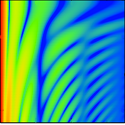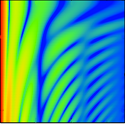High-field nuclear forward scattering
The Mössbauer effect, subject of the Nobel Prize in physics in 1961, relies on the resonant and recoilless emission and absorption of gamma rays from certain nuclei, the so-called “Mössbauer isotopes.” One of the most prominent Mössbauer isotopes is , which naturally makes up of iron. As such, Mössbauer spectroscopy has been very useful for studies of magnetism.
Nuclear forward scattering (NFS) is the time-resolved analog of Mössbauer spectroscopy. A typical Mössbauer spectroscopy experiment consists of exposing a sample to a radioactive source (e.g., ) and seeing how the radiation is absorbed by the resonant nuclei. By contrast, in NFS, tuned synchrotron radiation excites Mössbauer isotopes directly to cause transitions, and the resultant rays are measured.
Since NFS comprises a time lag between when the photons reach the nuclei to when the resonant rays are emitted, it has been impossible to use pulsed magnetic techniques to reach high-field regimes, since the field would not then be constant throughout the measurement. However, in a paper published in Physical Review Letters, Cornelius Strohm, Paul van der Linden, and Rudolf Rüffer, at the European Synchrotron Radiation Facility in Grenoble, France, use an ingenious detection scheme to perform NFS measurements on a polycrystalline film of -iron in fields up to . These measurements are at this stage mostly a proof of the principle, but the authors predict that access to a new, higher field regime can make NFS part of the arsenal of techniques used for studying a variety of magnetic solids composed of Mössbauer isotopes including not only , but also , , , and . – Daniel Ucko





